The global polycarbonate junction box market, valued at USD 1.4 billion in 2025 and projected to reach USD 2.2 billion by 2035 at a CAGR of 4.6%, reflects a balanced regional growth pattern with clear distinctions in demand drivers. North America is expected to remain a leading market, supported by widespread adoption in building automation systems, smart grid infrastructure, and telecommunications networks. The U.S. in particular will see strong demand from industrial modernization and smart city projects, where durable and weather-resistant polycarbonate junction boxes are increasingly preferred over traditional metallic enclosures.
Europe follows closely, underpinned by strict electrical safety standards and sustainability-focused regulations. Germany, France, and the UK are major contributors, with significant adoption in renewable energy installations, particularly solar and wind projects that require UV-resistant, corrosion-proof, and lightweight enclosure solutions. European demand will also be shaped by the growing retrofitting of existing electrical infrastructure, supporting steady market penetration across commercial and industrial facilities.
Asia-Pacific is forecasted to deliver the fastest growth rate, driven by rapid infrastructure development in China, India, and Southeast Asia. The expansion of industrial facilities, data centers, and telecommunications infrastructure in these regions will significantly increase the demand for polycarbonate junction boxes due to their durability and cost-effectiveness. Japan and South Korea, with their focus on smart infrastructure and advanced electronics, will add further growth momentum by integrating premium-grade enclosures into high-tech environments.
The Middle East and Africa, while smaller in overall share, are expected to record consistent demand from oil and gas facilities, large-scale construction projects, and emerging renewable energy installations in the Gulf states. Latin America, led by Brazil and Mexico, is showing steady adoption, particularly in urban infrastructure upgrades and commercial construction projects. The polycarbonate junction box market shows strong fundamentals with surface mount junction systems capturing a dominant share through advanced polycarbonate properties and industrial application optimization. Telecommunications applications drive primary demand, supported by increasing infrastructure requirements and electrical system modernization initiatives. Geographic expansion remains concentrated in developed markets with established electrical infrastructure, while emerging economies show accelerating adoption rates driven by industrial modernization initiatives and rising safety standards.
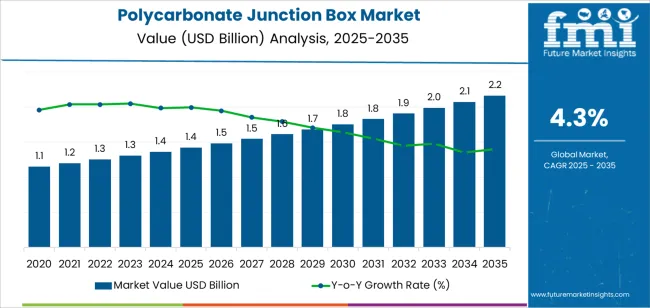
| Period | Primary Revenue Buckets | Share | Notes |
|---|---|---|---|
| Today | Surface mount junction boxes | 62% | Standard installations, industrial applications |
| Flush mount enclosures | 31% | Building integration, aesthetic requirements | |
| Specialized mounting systems | 7% | Custom applications, harsh environments | |
| Future (3-5 yrs) | Advanced surface mount systems | 55-58% | Enhanced protection, modular designs |
| Smart flush mount solutions | 28-32% | IoT integration, monitoring capabilities | |
| Telecommunications applications | 8-12% | 5G infrastructure, fiber networks | |
| Building automation enclosures | 6-10% | Smart buildings, HVAC systems | |
| Industrial process applications | 4-8% | Manufacturing facilities, process control | |
| Custom engineered solutions | 3-6% | Specialized requirements, harsh environments |
At-a-Glance Metrics
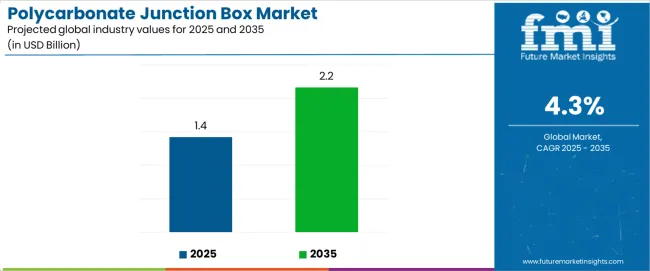
| Metric | Value |
|---|---|
| Market Value (2025) | USD 1.4 billion |
| Market Forecast (2035) | USD 2.2 billion |
| Growth Rate | 4.3% CAGR |
| Leading Mounting Type | Surface Mount Systems |
| Primary Application | Telecommunications Segment |
Design for environmental durability, not just protection
Infrastructure integration readiness
Quality-by-design approach
Value-based pricing models
Primary Classification: The market segments by mounting type into surface mount, flush mount, and others, representing the evolution from traditional wall-mounted installations to sophisticated integrated enclosure systems for comprehensive electrical protection optimization.
Secondary Classification: Application segmentation divides the market into telecommunications, building automation, and others, reflecting distinct requirements for enclosure performance, environmental protection standards, and electrical integration specifications.
Tertiary Classification: End-use segmentation covers electrical contractors, telecommunications providers, building operators, industrial manufacturers, and infrastructure developers, while distribution channels span direct sales, electrical distributors, and specialized industrial suppliers.
Regional Classification: Geographic distribution covers North America, Latin America, Western Europe, Eastern Europe, East Asia, South Asia Pacific, and Middle East & Africa, with developed markets leading adoption while emerging economies show accelerating growth patterns driven by infrastructure modernization programs.
The segmentation structure reveals mounting progression from traditional surface installations toward sophisticated integrated systems with enhanced protection capabilities, while application diversity spans from telecommunications infrastructure to industrial process control requiring precision enclosure solutions.
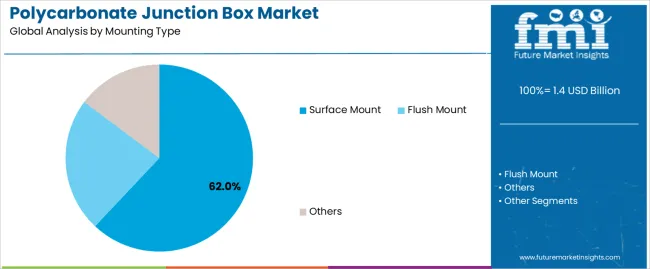
Market Position: Surface mount junction systems command the leading position in the polycarbonate junction box market with 62% market share through proven installation technologies, including flexible mounting options, accessible maintenance capabilities, and electrical integration optimization that enable contractors to achieve optimal protection performance across diverse industrial and commercial environments.
Value Drivers: The segment benefits from electrical industry preference for accessible enclosure systems that provide installation flexibility, maintenance access, and operational reliability without requiring embedded infrastructure modifications. Advanced surface mounting features enable enhanced cable management, easy service access, and integration with existing electrical systems, where protection performance and maintenance accessibility represent critical operational requirements.
Competitive Advantages: Surface mount junction systems differentiate through proven installation reliability, accessible maintenance characteristics, and integration with established electrical management systems that enhance facility effectiveness while maintaining optimal protection standards suitable for diverse industrial applications.
Key market characteristics:
Flush Mount Shows Integration Market Position
Flush mount junction systems maintain a 31% market position in the polycarbonate junction box market due to their aesthetic advantages and building integration positioning benefits. These installations appeal to facilities requiring discrete enclosure solutions with enhanced appearance profiles for commercial and architectural applications. Market growth is driven by building modernization expansion, emphasizing integrated electrical solutions and aesthetic optimization through concealed mounting designs.
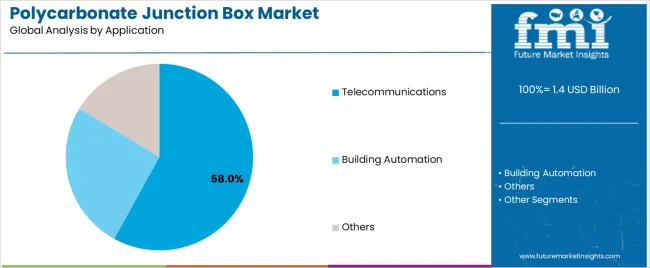
Market Context: Telecommunications applications demonstrate strong growth in the polycarbonate junction box market with 58% share, due to widespread adoption of infrastructure protection systems and increasing focus on network reliability, operational cost efficiency, and equipment protection applications that maximize enclosure effectiveness while maintaining service standards.
Appeal Factors: Telecommunications operators prioritize enclosure reliability, environmental protection, and integration with existing network infrastructure that enables coordinated protection operations across multiple service installations. The segment benefits from substantial telecommunications industry investment and modernization programs that emphasize the acquisition of premium enclosures for equipment protection and service continuity applications.
Growth Drivers: Network expansion programs incorporate polycarbonate junction boxes as essential components for infrastructure protection, while 5G deployment increases demand for enclosure capabilities that comply with environmental standards and minimize service disruption complexity.
Market Challenges: Varying environmental requirements and installation complexity may limit enclosure standardization across different network locations or service scenarios.
Application dynamics include:
Building Automation Applications Maintain Technology Demand
Building automation applications capture 24% market share through specialized control requirements in smart buildings, HVAC systems, and facility management applications. These installations demand premium enclosures capable of supporting system integration while providing environmental protection access and operational reliability capabilities.
Industrial Process Applications Show Manufacturing Growth
Industrial process applications account for 18% market share, including manufacturing facilities, process control systems, and industrial operations requiring performance enclosure capabilities for equipment protection and operational effectiveness.
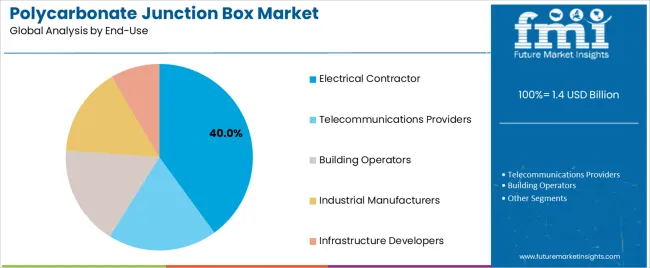
Market Context:Electrical contractors dominate the market, holding a 40% share, as they represent the primary demand source for polycarbonate junction box technology in electrical installation applications and infrastructure development.
Business Model Advantages: Electrical Contractors provide direct market demand for standardized enclosure systems, driving volume installation and cost optimization while maintaining quality control and safety compliance requirements.
Operational Benefits: Electrical Contractor applications include installation standardization, cost efficiency, and quality assurance that drive consistent demand for junction systems while providing access to latest protection technologies.
| Category | Factor | Impact | Why It Matters |
|---|---|---|---|
| Driver | Infrastructure modernization & electrical system upgrades (smart grids, industrial automation) | ★★★★★ | Growing electrical infrastructure market requires advanced enclosures with enhanced protection capabilities and durability properties proven effective across industrial applications. |
| Driver | Safety standards advancement & regulatory requirements (electrical codes, environmental protection) | ★★★★★ | Transforms enclosure requirements from "basic protection" to "comprehensive safety systems"; operators that offer compliant enclosures and advanced features gain competitive advantage. |
| Driver | Telecommunications expansion & 5G deployment (network infrastructure, fiber systems) | ★★★★☆ | Network operators need reliable, weather-resistant enclosures; demand for specialized and superior protection solutions expanding addressable market. |
| Restraint | Cost pressures & budget constraints (especially for smaller electrical contractors) | ★★★★☆ | Smaller electrical operators defer enclosure upgrades; increases price sensitivity and slows premium junction box adoption in cost-conscious markets. |
| Restraint | Alternative enclosure materials competition (metal boxes, fiberglass alternatives) | ★★★☆☆ | Traditional metal enclosures offer established supply chains and familiar installation methods, potentially limiting polycarbonate adoption in conservative applications. |
| Trend | Material technology integration & performance enhancement (UV resistance, impact protection) | ★★★★★ | Advanced polycarbonate properties, environmental optimization, and performance analytics transform operations; technology integration and protection enhancement become core value propositions. |
| Trend | Smart enclosure solutions & IoT integration (monitoring systems, predictive maintenance) | ★★★★☆ | Connected enclosures for remote monitoring and maintenance; specialized sensors and digital capabilities drive competition toward intelligent solutions. |
The polycarbonate junction box market demonstrates varied regional dynamics with Growth Leaders including China (5.8% growth rate) and India (5.4% growth rate) driving expansion through infrastructure development initiatives and electrical system modernization. Steady Performers encompass Germany (4.9% growth rate), Brazil (4.5% growth rate), and developed regions, benefiting from established electrical industries and safety standard adoption. Mature Markets feature United States (4.1% growth rate), United Kingdom (3.7% growth rate), and Japan (3.2% growth rate), where infrastructure advancement and regulatory compliance requirements support consistent growth patterns.
Regional synthesis reveals East Asian markets leading adoption through infrastructure expansion and electrical system development, while North American countries maintain steady expansion supported by enclosure technology advancement and safety standardization requirements. European markets show strong growth driven by industrial applications and compliance integration trends.
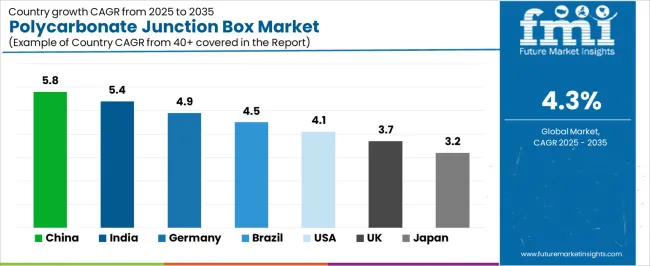
| Region/Country | 2025-2035 Growth | How to win | What to watch out |
|---|---|---|---|
| China | 5.8% | Focus on volume manufacturing solutions | Regulatory changes; local competition |
| India | 5.4% | Lead with cost-effective production | Import restrictions; quality barriers |
| Germany | 4.9% | Provide premium quality enclosures | Over-regulation; lengthy approvals |
| Brazil | 4.5% | Offer value-oriented solutions | Currency fluctuations; import duties |
| United States | 4.1% | Push technology integration | Compliance costs; scaling challenges |
| United Kingdom | 3.7% | Focus on premium applications | Economic impacts; enclosure costs |
| Japan | 3.2% | Emphasize quality manufacturing | Traditional preferences; adoption rates |
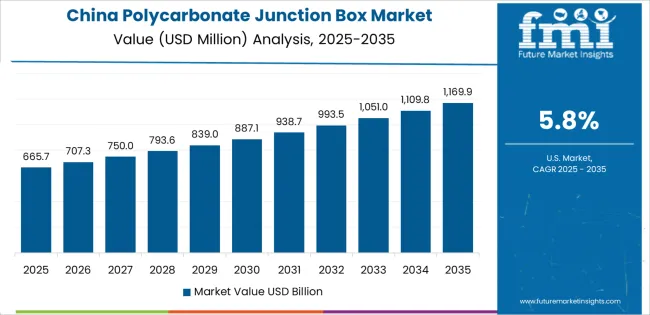
China establishes fastest market growth through aggressive infrastructure development programs and comprehensive electrical system expansion, integrating advanced polycarbonate junction systems as standard components in industrial facilities and telecommunications installations. The country's 5.8% growth rate reflects government initiatives promoting electrical infrastructure and domestic enclosure capabilities that mandate the use of professional junction systems in industrial and telecommunications facilities. Growth concentrates in major industrial hubs, including Shanghai, Shenzhen, and Suzhou, where infrastructure development showcases integrated enclosure systems that appeal to electrical contractors seeking protection optimization capabilities and industrial applications.
Chinese manufacturers are developing cost-effective junction solutions that combine domestic production advantages with advanced polycarbonate features, including enhanced environmental control and improved protection capabilities. Distribution channels through electrical suppliers and industrial distributors expand market access, while government support for infrastructure development supports adoption across diverse industrial and telecommunications segments.
Strategic Market Indicators:
In Mumbai, Delhi, and Bangalore, industrial facilities and telecommunications operators are implementing professional polycarbonate junction systems as standard equipment for electrical protection and operational optimization applications, driven by increasing government infrastructure investment and industrial modernization programs that emphasize the importance of safety protection capabilities. The market holds a 5.4% growth rate, supported by government infrastructure initiatives and manufacturing development programs that promote professional enclosure systems for industrial and telecommunications facilities. Indian operators are adopting junction systems that provide consistent electrical protection and environmental features, particularly appealing in urban regions where equipment protection and operational safety represent critical business requirements.
Market expansion benefits from growing industrial capabilities and international technology partnerships that enable domestic production of professional junction systems for industrial and telecommunications applications. Technology adoption follows patterns established in electrical equipment, where reliability and protection drive procurement decisions and operational deployment.
Market Intelligence Brief:
Advanced industrial market in Germany demonstrates sophisticated polycarbonate junction deployment with documented protection effectiveness in manufacturing applications and telecommunications facilities through integration with existing electrical systems and operational infrastructure. The country leverages engineering expertise in plastics and quality systems integration to maintain a 4.9% growth rate. Industrial centers, including North Rhine-Westphalia, Baden-Württemberg, and Bavaria, showcase premium installations where junction systems integrate with comprehensive electrical platforms and facility management systems to optimize equipment protection and operational effectiveness.
German manufacturers prioritize system quality and EU compliance in junction development, creating demand for premium systems with advanced features, including facility integration and environmental protection systems. The market benefits from established industrial infrastructure and a willingness to invest in professional junction technologies that provide long-term operational benefits and compliance with international safety standards.
Market Intelligence Brief:
Polycarbonate junction box market expansion in Brazil benefits from diverse industrial demand, including infrastructure modernization in São Paulo and Rio de Janeiro, manufacturing facility upgrades, and government industrial programs that increasingly incorporate professional junction solutions for electrical applications. The country maintains a 4.5% growth rate, driven by rising industrial activity and increasing recognition of professional junction benefits, including precise protection control and enhanced operational effectiveness.
Market dynamics focus on cost-effective junction solutions that balance electrical protection performance with affordability considerations important to Brazilian industrial operators. Growing industrial modernization creates continued demand for modern junction systems in new infrastructure and facility upgrade projects.
Strategic Market Considerations:
United States establishes market leadership through comprehensive electrical programs and advanced infrastructure development, integrating polycarbonate junction systems across industrial and telecommunications applications. The country's 4.1% growth rate reflects established electrical industry relationships and mature enclosure technology adoption that supports widespread use of professional junction systems in industrial and telecommunications facilities. Growth concentrates in major industrial centers, including Texas, California, and the Great Lakes region, where junction technology showcases mature deployment that appeals to electrical contractors seeking proven protection capabilities and operational efficiency applications.
American electrical providers leverage established distribution networks and comprehensive technical support capabilities, including installation programs and training support that create customer relationships and operational advantages. The market benefits from mature regulatory standards and electrical requirements that mandate junction system use while supporting technology advancement and operational optimization.
Market Intelligence Brief:
United Kingdom's industrial market demonstrates integrated polycarbonate junction deployment with documented protection effectiveness in manufacturing applications and telecommunications facilities through integration with existing electrical systems and operational infrastructure. The country maintains a 3.7% growth rate, supported by industrial excellence programs and protection effectiveness requirements that promote professional junction systems for industrial applications. Manufacturing facilities across England, Scotland, and Wales showcase systematic installations where junction systems integrate with comprehensive electrical platforms to optimize equipment protection and operational outcomes.
UK electrical providers prioritize system reliability and industry compatibility in junction procurement, creating demand for validated systems with proven protection features, including performance monitoring integration and environmental protection systems. The market benefits from established industrial infrastructure and excellence requirements that support junction technology adoption and operational effectiveness.
Market Intelligence Brief:
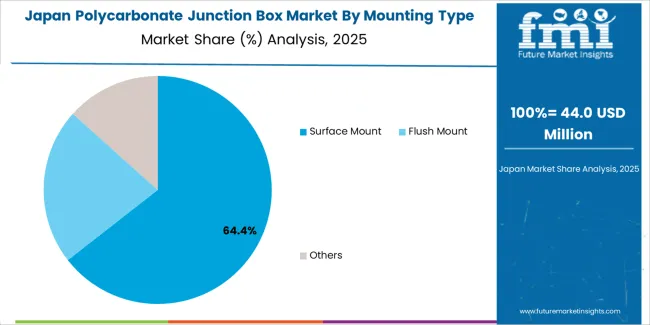
Polycarbonate junction box market growth in Japan benefits from precision industrial demand, including advanced manufacturing facilities in Tokyo and Osaka, quality integration, and operational enhancement programs that increasingly incorporate junction solutions for protection applications. The country maintains a 3.2% growth rate, driven by industrial technology advancement and increasing recognition of precision junction benefits, including accurate protection control and enhanced operational outcomes.
Market dynamics focus on high-precision junction solutions that meet Japanese quality standards and protection effectiveness requirements important to industrial operators. Advanced industrial technology adoption creates continued demand for sophisticated junction systems in manufacturing facility infrastructure and operational modernization projects.
Strategic Market Considerations:
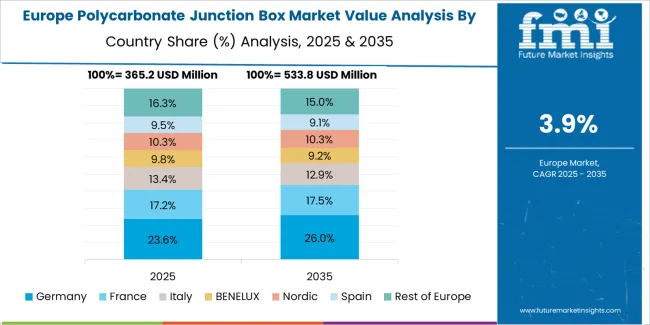
The European polycarbonate junction box market is projected to grow from USD 284.8 million in 2025 to USD 441.2 million by 2035, registering a CAGR of 4.5% over the forecast period. Germany is expected to maintain its leadership position with a 42.3% market share in 2025, supported by its advanced industrial infrastructure and major manufacturing centers.
United Kingdom follows with a 28.1% share in 2025, driven by comprehensive electrical programs and infrastructure development initiatives. France holds a 16.4% share through specialized industrial applications and regulatory compliance requirements. Italy commands a 8.9% share, while Spain accounts for 4.3% in 2025. The rest of Europe region is anticipated to gain momentum, expanding its collective share from 2.1% to 2.6% by 2035, attributed to increasing industrial adoption in Nordic countries and emerging manufacturing facilities implementing infrastructure modernization programs.
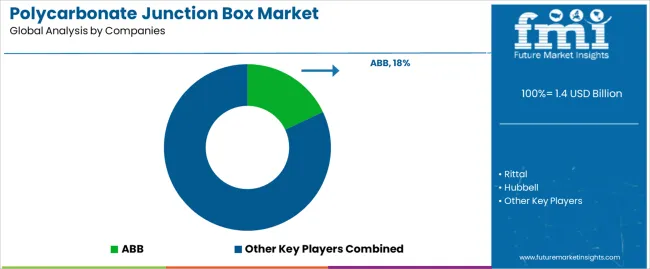
| Stakeholder | What they actually control | Typical strengths | Typical blind spots |
|---|---|---|---|
| Global brands | Distribution reach, broad product catalogs, manufacturing scale | Wide availability, proven quality, multi-region support | Product refresh cycles; customer dependency on brand validation |
| Technology innovators | Material R&D; advanced polycarbonate technologies; smart features | Latest technologies first; attractive ROI on performance effectiveness | Service density outside core regions; scaling complexity |
| Regional specialists | Local compliance, fast delivery, nearby customer support | "Close to customer" support; pragmatic pricing; local regulations | Technology gaps; talent retention in customer service |
| Full-service providers | Complete solutions, installation services, technical support | Lowest operational risk; comprehensive support | Service costs if overpromised; technology obsolescence |
| Niche specialists | Specialized applications, custom enclosures, harsh environment solutions | Win premium applications; flexible configurations | Scalability limitations; narrow market focus |
| Item | Value |
|---|---|
| Quantitative Units | USD 1.4 billion |
| Mounting Type | Surface Mount, Flush Mount, Others |
| Application | Telecommunications, Building Automation, Others |
| End Use | Electrical Contractors, Telecommunications Providers, Building Operators, Industrial Manufacturers, Infrastructure Developers |
| Regions Covered | North America, Latin America, Western Europe, Eastern Europe, East Asia, South Asia Pacific, Middle East & Africa |
| Countries Covered | China, India, Germany, Brazil, United States, United Kingdom, Japan, Canada, France, Australia, and 25+ additional countries |
| Key Companies Profiled | ABB, Rittal, Hubbell, Schneider Electric, Eaton, ENSTO, AttaBox, Fibox Enclosures, nVent Hoffman |
| Additional Attributes | Dollar sales by mounting type and application categories, regional adoption trends across East Asia, North America, and Western Europe, competitive landscape with enclosure manufacturers and electrical suppliers, electrical contractor preferences for junction effectiveness and protection performance, integration with electrical systems and monitoring platforms, innovations in polycarbonate technology and enclosure enhancement, and development of advanced junction solutions with enhanced protection and operational optimization capabilities. |
The global polycarbonate junction box market is estimated to be valued at USD 1.4 billion in 2025.
The market size for the polycarbonate junction box market is projected to reach USD 2.2 billion by 2035.
The polycarbonate junction box market is expected to grow at a 4.3% CAGR between 2025 and 2035.
The key product types in polycarbonate junction box market are surface mount , flush mount and others.
In terms of application, telecommunications segment to command 58.0% share in the polycarbonate junction box market in 2025.






Full Research Suite comprises of:
Market outlook & trends analysis
Interviews & case studies
Strategic recommendations
Vendor profiles & capabilities analysis
5-year forecasts
8 regions and 60+ country-level data splits
Market segment data splits
12 months of continuous data updates
DELIVERED AS:
PDF EXCEL ONLINE
Polycarbonate Composites Market Size and Share Forecast Outlook 2025 to 2035
Polycarbonate Films Market Size and Share Forecast Outlook 2025 to 2035
Polycarbonate Resins Market - Trends & Forecast 2025 to 2035
Polycarbonate Sheet Market Growth – Trends & Forecast 2024-2034
Super Junction MOSFET Market
Automotive Junction Box Market Size and Share Forecast Outlook 2025 to 2035
Gastroesophageal Junction Adenocarcinoma Therapeutics Market by Drug, Diagnosis, Treatment, Distribution Channel, and Region through 2035
Box Liners Market Size and Share Forecast Outlook 2025 to 2035
Boxboard Packaging Market Analysis - Size, Share, and Forecast Outlook 2025 to 2035
Box Compression Tester Market Size and Share Forecast Outlook 2025 to 2035
Box Latch Market Size and Share Forecast Outlook 2025 to 2035
Box Pouch Market by Pouch Type from 2025 to 2035
Box Filling Machine Market from 2025 to 2035
Box and Carton Overwrap Films Market Demand and Growth
Box and Carton Overwrapping Machines Market Insights and Growth 2025 to 2035
Boxcar Scars Market – Demand, Growth & Forecast 2025 to 2035
Box Sealing Machines Market Trends – Growth & Forecast 2025 to 2035
Competitive Breakdown of Box Pouch Providers
Market Share Insights of Boxboard Packaging Providers
Box Latch Market Positioning & Competitive Analysis

Thank you!
You will receive an email from our Business Development Manager. Please be sure to check your SPAM/JUNK folder too.
Chat With
MaRIA